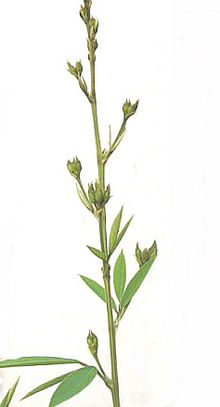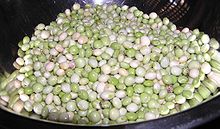- Pigeon pea
-
Pigeon pea 
Scientific classification Kingdom: Plantae (unranked): Angiosperms (unranked): Eudicots (unranked): Rosids Order: Fabales Family: Fabaceae Genus: Cajanus Species: C. cajan Binomial name Cajanus cajan
(L.) Millsp.The pigeon pea (International Feed Number, 5-03-716), also known as tropical green pea, toor dāl or arhar dāl (India), ತೊಗರಿ ಬೇಳೆ (Kannada) kadios (Philippines), or Congo pea or gungo pea (in Jamaica), pois Congo (in Haiti), gandul (in Puerto Rico), gunga pea, or no-eye pea, [Cajanus cajan, synonyms Cajanus indicus Spreng. (Valder 1895) and Cytisus cajan (Crawfurd 1852)] is a perennial member of the family Fabaceae. Pigeonpea also happens to be the first seed legume plant to have complete genome sequence by the efforts of ICAR [1] it was a totally indigenous effort by Indian scientists following which some other groups also published some related work. [2]
Contents
Origins
The cultivation of the pigeon pea goes back at least 3500 years. The centre of origin is the eastern part of peninsular India, including the state of Orissa, where the closest wild relatives (Cajanus cajanifolia) occur in tropical deciduous woodlands[3]. Archaeological finds of pigeonpea include those from two Neolithic sites in Orissa, Gopalpur and Golbai Sassan dating between 3400 and 3000 years ago, and sites in South India, Sanganakallu and Tuljapur Garhi, also dating back to 3400 years ago [4]. From India it traveled to East Africa and West Africa. There is was first encountered by Europeans, so it obtained the name Congo Pea. By means of the slave trade it came to the American continent, probably in the 17th century [5].
Cultivation
Today, pigeon peas are widely cultivated in all tropical and semitropical regions of both the Old and the New Worlds. Pigeon peas can be of a perennial variety, in which the crop can last three to five years (although the seed yield drops considerably after the first two years), or an annual variety more suitable for seed production.
Pigeon peas are an important legume crop of rainfed agriculture in the semiarid tropics. The Indian subcontinent, Eastern Africa and Central America, in that order, are the world's three main pigeon pea-producing regions. Pigeon peas are cultivated in more than 25 tropical and subtropical countries, either as a sole crop or intermixed with cereals, such as sorghum (Sorghum bicolor), pearl millet (Pennisetium glaucum), or maize (Zea mays), or with other legumes, such as peanuts (Arachis hypogaea). Being a legume, the pigeon pea enriches soil through symbiotic nitrogen fixation.
The crop is cultivated on marginal land by resource-poor farmers, who commonly grow traditional medium- and long-duration (5–11 months) landraces. Short-duration pigeon peas (3–4 months) suitable for multiple cropping have recently been developed. Traditionally, the use of such input as fertilizers, weeding, irrigation, and pesticides is minimal, so present yield levels are low (average = 700 kg/ha). Greater attention is now being given to managing the crop because it is in high demand at remunerative prices.
Pigeon peas are very drought resistant, so can be grown in areas with less than 650 mm annual rainfall.
World production of pigeon peas is estimated at 46,000 km2. About 82% of this is grown in India. These days it is the most essential ingredient of animal feed used in West Africa, most especially in Nigeria, where it is also grown.
Uses
Pigeon peas are both a food crop (dried peas, flour, or green vegetable peas) and a forage/cover crop. They contain high levels of protein and the important amino acids methionine, lysine, and tryptophan.[6] In combination with cereals, pigeon peas make a well-balanced human food. The dried peas may be sprouted briefly, then cooked, for a flavor different from the green or dried peas. Sprouting also enhances the digestibility of dried pigeon peas via the reduction of indigestible sugars that would otherwise remain in the cooked dried peas.[7]
In India, split pigeon peas (toor dal) are one of the most popular pulses, being an important source of protein in a mostly vegetarian diet. In regions where it grows, fresh young pods are eaten as a vegetable in dishes such as sambar. In Ethiopia, not only the pods, but also the young shoots and leaves are cooked and eaten.[8]
In some places, such as the Dominican Republic and Hawaii, pigeon peas are grown for canning and consumption. A dish made of rice and green pigeon peas (called moro de guandules) is a traditional food in Dominican Republic. Pigeon peas are also made as a stew, with plantain balls. In Puerto Rico arroz con gandules is made with rice and pigeon peas and is a typical dish. Trinidad and Tobago and Grenada have their own variant, called pelau, which includes either beef or chicken, and occasionally pumpkin and pieces of cured pig tail.
In Thailand, pigeon peas are grown as a host for scale insects which produce lac.
Pigeon peas are in some areas an important crop for green manure, providing up to 40 kg nitrogen per hectare. The woody stems of pigeon peas can also be used as firewood, fencing and thatch.
Genome Sequence
The pigeon pea genome genome was first sequenced by a group of 31 Indian scientists from the Indian Council of Agricultural Research under the leadership of Nagendra Kumar Singh. The sequencing of the genome will assist plant breeders in being able to breed new and improved varieties. This effort by ICAR was a pioneering event as it was the first time in the history of mankind that a legume genome was sequenced. The paper is published in one of India's leading journal
Nature Biotechnology has published pigeonpea genome sequence led by International Crops Research Institute for the Semi-Arid Tropics (ICRISAT) under the leadership of Dr Rajeev K Varshney through International Initiative for Pigeonpea Genomics (IIPG).
There is controversy between the mentioned publications (Nature India) and also in INDIAN AGRARIAN CRISIS. Eventually, pigeonpea crop will be benefited as these two genome sequences can be merged in near future.
Pathogens
- Phytophthora cajani
References
- ^ Nagendra Kumar Singh et al. (2011)The First Draft of pigeon pea genome sequence. J. Plant Biochem Biotechnol DOI 10.1007/s13562-011-0088-8
- ^ Varshney et al. (2011) Draft genome sequence of pigeonpea (Cajanus cajan), an orphan legume crop of resource-poor farmers. Nature Biotechnology doi:10.1038/nbt.2022
- ^ Van der Maeson, L. J. G. (1995). Pigeonpea Cajanus cajan, pp. 251–5 in Smartt, J. and Simmonds, N. W. (eds.), Evolution of Crop Plants. Essex: Longman.
- ^ Fuller,D.Q. & Harvey,E. (2006). The archaeobotany of Indian Pulses: identification, processing and evidence for cultivation. Environmental Archaeology 11(2), 219-246.[1]
- ^ Carney, J. A. and Rosomoff, R. N. (2009) In the Shadow of Slavery. Africa’s Botanical legacy in the Atlantic World. Berkeley: University of California Press
- ^ "Nutrition Facts and Analysis for Pigeon peas (red gram), mature seeds, raw"
- ^ "Effect of Sprouting on invitro digestibility of some locally consumed leguminous seeds". Journal of Applied Sciences and Environmental Management. Vol. 10, Num. 3, 2006, pp. 55-58
- ^ Zemede Asfaw, "Conservation and use of traditional vegetables in Ethiopia", Proceedings of the IPGRI International Workshop on Genetic Resources of Traditional Vegetables in Africa (Nairobi, 29-31 August 1995)
External links
- Crop Wild Relatives Gap Analysis Portal reliable information source on where and what to conserve ex-situ, regarding Cajanus genepool
- (http://fcit.usf.edu/florida/docs/v/veg.htm)
- (http://www.springerlink.com/content/g78774q222672082/fulltext.pdf)
- (http://www.nrcpb.org/content/nrcpb-scientists-succeeded-decoding-arhar-dal-genome)
- (http://www.icar.org.in/node/3815)
- (http://www.nature.com/nbt/journal/vaop/ncurrent/full/nbt.2022.html)
- (http://www.icrisat.org/newsroom/latest-news/happenings/happenings1492.htm#1)
- (http://www.icrisat.org/newsroom/news-releases/icrisat-pr-2011-media20.htm)
Categories:- Faboideae
- Edible legumes
- Tropical agriculture
- Crops originating from India
- Flora of Jamaica
- Puerto Rican ingredients
Wikimedia Foundation. 2010.





